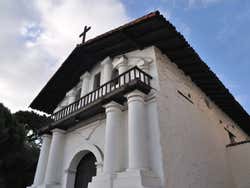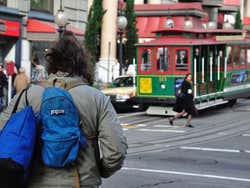
San Francisco History
Discover the history of San Francisco, from the arrival of the Spanish to it becoming the leading technological city it is today.
The Arrival of the Spanish
San Francisco Bay was inhabited by Indian tribes for thousands of years. When the Spanish came, tribes like the Mojave and others who spoke the Yuma language were already living there.
On 28th September 1542, the Spaniard Juan Rodríguez Cabrillo was the first European to set foot on Californian soil. In 1577 the Englishman Drake also came to California, which he named New Albion, although it was the Spanish Jesuits who were the first to set up their famous missions there.
In 1767 King Carlos III of Spain ordered the expulsion of the Jesuits from his lands, who at the time had fourteen missions. An expedition led by Gaspar de Portolá and Friar Junípero Serra, who travelled throughout California with the idea of expelling members of the Company of Jesus from their missions and putting Franciscan monks in their place, arrived in the bay in 1770 where they founded San Francisco.
In 1776 the Spanish explorer Juan Bautista de Anza built the San Francisco prison and founded a mission in honour of Saint Francis of Assisi, now known as Mission Dolores and so the city of San Francisco was born.
In 1792 the explorer George Vancouver established a small base near the Spanish mission which he named Yerba Buena, where many English, Russian and other European colonists settled themselves.
Plagued by numerous problems, Spain stopped being concerned about California, which brought about the arrival of the Russians who founded Fort Ross next to San Francisco in 1812.
In 1822 Mexico gained independence from Spain and the area went over to its control. After this seizure, the mission of San Francisco was abandoned.
Gold Fever in California
Under the mandate of Commodore John Drake Sloat, California declared independence from Mexico and was declared a territory of the United States in 1846. One year later, on January 30, 1847, the Americans changed the original name of Yerba Buena to San Francisco.
In 1848 gold was discovered in the Coloma valley area of "New Helvetia", starting the "California Gold Rush." For a while, San Francisco was known as "New Helvitia" due to the purchase that a Swiss adventurer, John Sutter, made from the Russian colonists who were based in California.
The Gold Rush especially benefitted San Francisco, which entered a period of rapid growth, becoming the largest city on the west coast.
In 1869 the railroad arrived in California and with it, English influence. The "New Americans" made discriminatory laws against the large Japanese, Chinese and Hispanic populations.
San Francisco in the 20th Century
On 18th April 1906 the famous earthquake practically destroyed the city, especially the historical area. The reconstruction was so fast that only nine years later, in 1915 the city was chosen as the venue for the Panama-Pacific International Exposition.
One year earlier in 1914, the Panama Canal was opened, which created an incredible economic growth in San Francisco.
San Francisco’s two most emblematic bridges were built in the 1930s, the bridge linking San Francisco and Oakland in 1936 and the world-famous Golden Gate Bridge in 1937.
During the Second World War, shipyards were built in San Francisco to meet the demand for warships, and it was converted into the main port of departure for the war in the Pacific.
After the war, the nations met in San Francisco for the last conference that would give birth to the United Nations (UN) and the dissolution of the League of Nations.
San Francisco, Liberal and Technological
In the 1990s San Francisco became the centre for many companies providing new technologies, benefitting from its proximity to Silicon Valley.
Today, San Francisco, the city where it is always windy, competes with Los Angeles as the technological, financial and cultural centre of California. It has been associated with Haight-Ashbury and alternative movements and is considered one of the most open, liberal cities in the United States.
While the city's economic growth has created thousands of new jobs, it, in turn, has caused a huge housing shortage leading to rent increasingly exponentially. This has consequently led to a severe homelessness crisis, something often noted by visitors. The city's politicians claim that the issue is a priority, and clear efforts are being made to improve the levels of homelessness. There is no doubt that San Francisco is a unique city loved by the millions of tourists that visit every year, but it should be noted that when you visit the famous landmarks, museums and attractions, there are often evident underlying social problems.


